
The following article by Charles Hartley originally appeared in The Courier-Journal on 20 Mar 2013. It is archived here with additional information for your reading enjoyment.
The decade following the end of the First World War saw increased consumer spending and economic growth, and businesses sprouted up, not only in large cities, but in small towns like Shepherdsville. Here the former courthouse square was the town's business center. It was located at the intersection of Main and Second Streets (now Buckman Street and Joe B. Hall Ave).
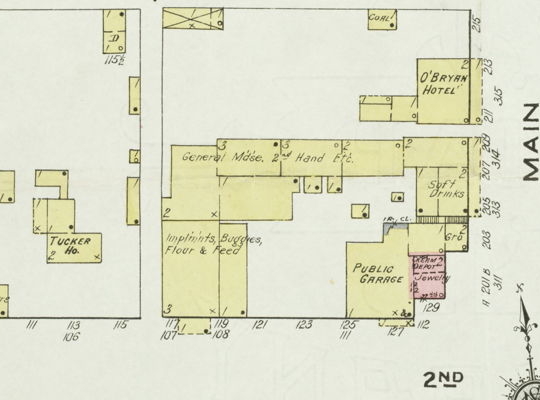
The Maraman family had a large store on the southwest corner. Across Main Street was the Troutman Bros. Mammoth Store that sold everything from baby's cradles to caskets. The Troutmans also had a furniture store on the northeast corner, and in the block on the northwest corner stood a variety of businesses from farm implements to second hand clothes to a small jewelry store, as well as a grocery store and a soda fountain.
As darkness settled over the town on Thursday evening, February 23, 1922, most of the town's citizens were soon asleep. However, two men, Winfrey Spears and Urey Tucker, were sitting up with the remains of Mrs. Nellie Shepherd at the Tucker Hotel.
They happened to notice light reflecting off the side of a newly painted wagon bed that sat on Second Street just outside the Lutes implements store. Investigating, they discovered that the light was coming from a fire up the street in the storeroom of Armstrong & Hall, and quickly sounded the alarm.
I wish I could say that the fire department responded promptly and put out the blaze, but at that time there was no fire department, just citizens with buckets and pans and anything else that would hold water dipped out of the town's few cisterns.
The whole square was doomed and people directed their attention to saving the goods from the stores of Armstrong & Hall, John Boes, G. S. Patterson, Smith & Smith, and Jess Weatherford's small jewelry store.
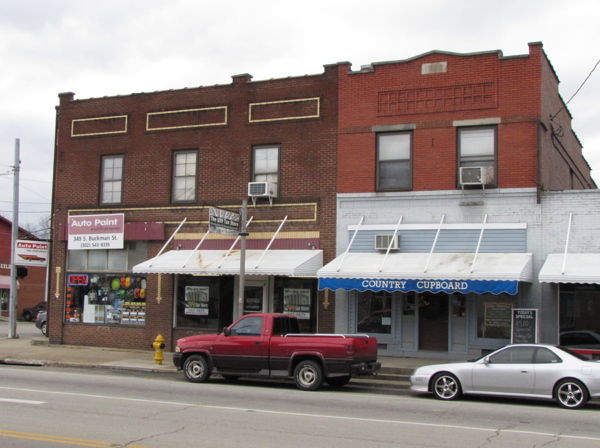
With a gentle breeze out of the southwest, the fear was that the fire would jump Main Street and ignite everything there as far as the railroad tracks. Then it shifted and began blowing out of the northeast, reversing the fire's direction. Next it jumped the alley to the west and quickly consumed the small Tucker Hotel as well.
Except for the small former brick jail that sat on the corner, every other building was built of wood, and the next morning the only things standing on the block were the new Peoples Bank on its northern border, and a single brick wall of the old jail.
Despite the great loss, several businessmen were quick to build again. Noah and Everett Smith, father and son, invested in a new building, while John Boes hired the firm that was building the new Bullitt County Bank across the street to build a new grocery store for him, also out of brick. Boes Grocery Store is now the home of Kit Parker's Country Cupboard, my favorite place to eat lunch.
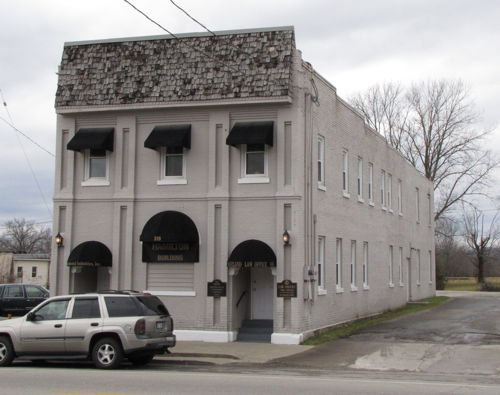
The newspaper called for improvements, writing "We need better and safer buildings and we need a fire fighting unit of some kind and then we need several big cisterns in our streets filled with water." As was the case in so many small towns however, bucket brigades continued to serve as the town's only fire protection.
In October the residence of Mrs. Minnie Maraman was destroyed by fire. That same month the large home of Mrs. A. E. Funk at Brooks burned to the ground.
There were some successes. In February 1923, the roof and rafters of the Patterson home caught fire from burning chimney soot but was discovered in time to hoist water up to Roy Simmons and Charles Morrison who had opened a hole to get to the fire.
However, the efforts of almost the entire town were not enough to save J. F. Comb's home in April 1924. It was considered one of the town's finest homes.
Then just before Christmas in 1927, the big department store of Troutman Bros., covering about one half of a block, burned to the ground. It started at the still hour of night and no wind blowing, and with the morning dew falling, the fire did not spread, but the loss was estimated at $150,000, only partly covered by insurance.
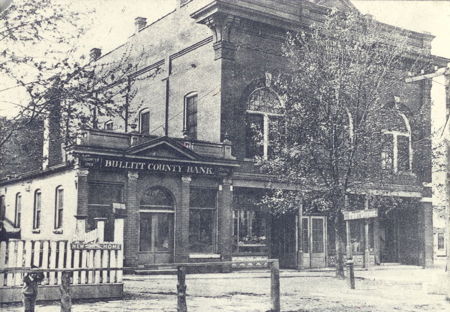
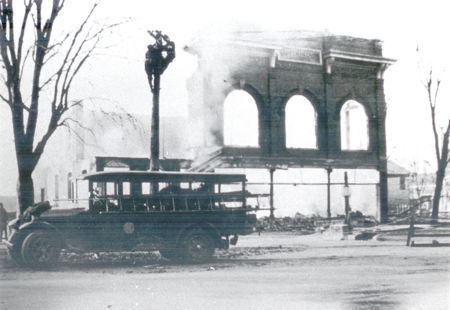
It seems ironic that the advertisement shown below appeared in the same issue of the newspaper that reported the fire destroying this store.
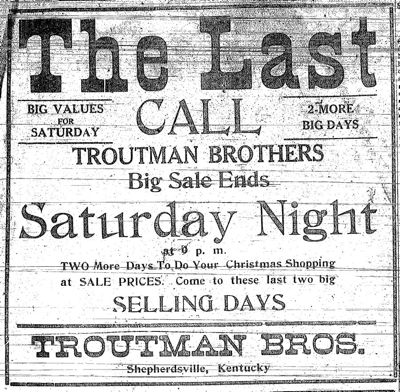
Once again the newspaper called for a fire department. It wrote, "Since the big fire which destroyed the Troutman Bros. block everyone sees that we need a fire department here and some good big cisterns. If the town, county and citizens would go to work and all get together and dig about three big cisterns and get a small fire engine, we could save enough in two years on insurance rates to pay for it and then our property would be protected. Won't every one go to work and help get a fire department here before another fire destroys the rest of the town?"
I understand that the establishment of the Shepherdsville Fire Department dates from about that time, so the paper's pleas were heard at last.
Fires can still be great tragedies today, but we are grateful to the brave firefighters of our communities who stand against fires like the ones that destroyed much of Shepherdsville in the 1920s.
Copyright 2013 by Charles Hartley, Shepherdsville KY. All rights are reserved. No part of the content of this page may be included in any format in any place without the written permission of the copyright holder.
The Bullitt County History Museum, a service of the Bullitt County Genealogical Society, is located in the county courthouse at 300 South Buckman Street (Highway 61) in Shepherdsville, Kentucky. The museum, along with its research room, is open 10 a.m. to 4 p.m. Monday through Friday. Saturday appointments are available by calling 502-921-0161 during our regular weekday hours. Admission is free. The museum, as part of the Bullitt County Genealogical Society, is a 501(c)3 tax exempt organization and is classified as a 509(a)2 public charity. Contributions and bequests are deductible under section 2055, 2106, or 2522 of the Internal Revenue Code. Page last modified: 12 Sep 2024 . Page URL: bullittcountyhistory.org/memories/fires1920s.html